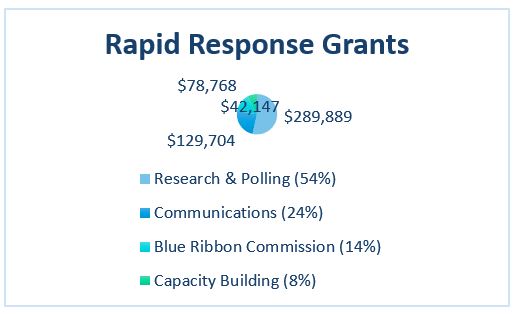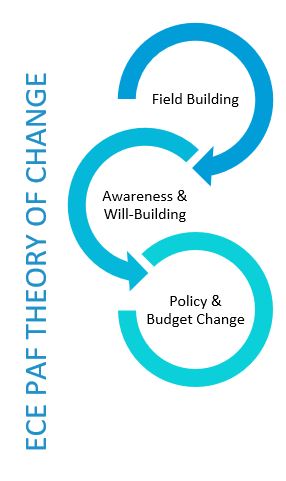February 2024
In 2016, First 5 Los Angeles- a quasi-government agency—responded to a need for Early Care & Education (ECE) systems change in a way that was supportive, dynamic, and replicable. This is the story of how a public, government organization can be an agent of policy change while supporting a broader ecosystem of organizations. It’s also the story of leading with flexibility, trust, and relationships instead of only transactional, tactical wins – resulting in a more durable Early Care & Education field that is respected in Sacramento and extremely effective, even during the most trying times.
When public funder leverages power differently, with a grantee-centered, field-building approach, a more durable field emerges with meaningful policy wins that support children and their families.
The Early Care and Education Policy and Advocacy Fund (ECE PAF) was a six-year, $17 million investment to strengthen existing advocacy efforts and increase collaboration among organizations working to improve access to quality early care and education in Los Angeles County. Unlike other initiatives that have identified a specific policy change and “hired” grantees to implement it, ECE PAF was a strategic investment by a public funder to invest in an ecosystem of ECE advocates. The fund targeted a historically fragmented field struggling to elevate ECE as a priority in Sacramento; the initiative provided grantees an opportunity to deepen their relationships, as well as strengthen the impact of the longstanding ECE Coalition.
ECE PAF DESIGN ELEMENTS:
While philanthropic policy advocacy and systems change funding has recently increased, First 5 Los Angeles has been at the forefront of this journey for nearly 15 years, continually evolving their praxis. Beginning in 2008, First 5 LA began with a small but explicit systems and policy change focus through a subset of their capacity building grantees, the Community Opportunities Fund (COF). This commitment was deepened through their Policy Advocacy Fund (PAF), cohorts I and II. Findings from the report, “Strengthening Policy Advocacy: A Decade of Lessons Learned from the First 5 Los Angeles Policy Advocacy Fund 2008-2018” (Ersoylu, November 2018), identified four key lessons from this work:
- F5LA can be a strategic advocate alongside its grantees
- Impactful advocacy funding must be multi-year
- Advocacy funding must be both fluid (context-responsive) and focused (issue-specific)
- Technical assistance must be tailored for the grantees
As a result, ECE PAF was designed to be responsive and evolving. Because it was a multi-year initiative, planning and preparation time was built in; grant pools and guidelines were co-designed with involvement of the funder, an intermediary organization, learning team, prospective grantees, and other key stakeholders.
SYMBIOTIC FUNDING ELEMENTS
 What emerged was a multi-level funding strategy not based explicitly on funder ideas but with input from leaders in the field. Three funding streams were woven together to create flexibility of the initiative. Partnership Grants were provided to six (6) larger organizations with a proven track record of state and local policy change; these ranged from $200-450k, renewable annually for five years.
What emerged was a multi-level funding strategy not based explicitly on funder ideas but with input from leaders in the field. Three funding streams were woven together to create flexibility of the initiative. Partnership Grants were provided to six (6) larger organizations with a proven track record of state and local policy change; these ranged from $200-450k, renewable annually for five years.
The Field Building Grants provided $75,000 each to ten (10) either smaller, more niche ECE-focused organizations or successful multi-issue advocacy organizations newer to ECE work who could add value to the overall ECE space—especially policy change and movement-building in Los Angeles.
Third, the Rapid Response Fund was a way for grantees to respond in time-sensitive, targeted ways. The average grant award was $50,000 and fulfilled needs that would benefit the field overall, such as research, polling, or communications. Over $500,000 was distributed.

Typically, funders – particularly government funders – cannot move quickly when a new idea emerges. This can lead to operating with a sense of scarcity rather than abundance about shared projects, creating strained relationships and decreased effectiveness. This fund was able to address both issues – with a field-level orientation – in real time.
INTERMEDIARY
A differentiator between this fund and “business as usual” was the intermediary structure. Community Partners, an organization that provides administrative infrastructure and connections for large-scale regranting, convening and capacity-building initiatives, provided staff and consultants who served the intermediary role, available to provide as-needed support. This resulted in thought partnership between peers rather than a formal grantee-funder technical assistance rapport. For First 5 LA to have a skilled team to support both the grantees and First 5 LA, made the initiative highly responsive to opportunities that arose in the broader ecosystem.
Community Partners’ ability to absorb the bureaucratic load (managing proof of insurances, certifications, monthly cost-reimbursement invoicing, etc.) and simplify application and reporting processes allowed ECE PAF to look and feel more like private funding. This model allowed for First 5 LA to remain highly accountable as a public agency stewarding taxpayer funds and demonstrating positive outcomes, while trying to limit the administrative burden on grantees. The intermediary also provided some distance so First 5 LA staff could primarily show up as policy advocates alongside grantees, and less as a funder.
CONVENINGS
The intermediary designed and facilitated highly interactive, engaging meetings where trust and relationship-building were paramount. The convenings were not conventional—they were not a space where grantees focused on strategy or policy development or listened to guest speakers. Rather, the meetings were designed with opportunities for trust-building activities, with “walking breakout sessions” (out in nature, pre-COVID) planned for pairs or trios who may not have worked closely in the past could “get to know one another.” The intentionality behind what was seemingly a whimsical wellbeing-focused component was extremely powerful for field building.
Grantee evaluations continually noted how the convenings were not only enjoyable, but they felt trust was actively built. In addition, the funder was able to take a “both-and” approach, supporting the grantee convenings while at the same time, participating in and funding the broader ECE Coalition, a separate table where the more policy-focused strategy discussions were taking place.
IMPACT:
ECE PAF had a clear framework whereby the initiative would impact policy and strengthen the broader ECE field. During the 6-year period, substantial impact was noted across three (3) outcome areas.
FIELD-BUILDING
 Fragmentation in the field declined from a baseline of 75% of grantees identifying it as an issue in 2017 to only 37.5% in 2021. Furthermore, compared to 2017, the grantees reported that the ECE advocacy field in 2021 is more effective at both making budgetary impacts (100% agree) and policy change (88% agree).
Fragmentation in the field declined from a baseline of 75% of grantees identifying it as an issue in 2017 to only 37.5% in 2021. Furthermore, compared to 2017, the grantees reported that the ECE advocacy field in 2021 is more effective at both making budgetary impacts (100% agree) and policy change (88% agree).
Increased communication among grantees and increased collaborative policy advocacy were reported as well. Substantial work was done to strengthen the ECE Coalition’s ability to impact the broader field, creating internal policies, procedures, and guiding bylaws; this resulted in 88% of grantees feeling confident in the ability of the ECE Coalition to secure meaningful policy wins.
INCREASED AWARENESS
Over 2,400 visits (in-person and virtual) to elected officials and their staff took place. In addition, grantees engaged in various coalitions, networks, and non-traditional venues to share the vision and agenda of the broader ECE field.
POLICY & BUDGET OUTCOMES
Beginning in the 2018-19 budget cycle, grantees collaborated on the unprecedented “Billions for Babies” budget request, a $1 billion investment, improving access for approximately 100,000 children and needed supports for providers to care for more infants and toddlers. This marked the first time the ECE Coalition had clear budgetary asks aligned to bills.
After having grantees support and/or sponsor over three dozen pieces of ECE legislation during the six-year period, with nearly 20 of these supported by the ECE Coalition, five bills were signed into law, along with funding for nine of the budgetary requests for ECE funding.
LESSONS LEARNED:
Trust can indeed be built structurally. Intentionally creating spaces to develop relationships yielded clear results in grantee-to-grantee rapports. Taking the time to thoughtfully create these opportunities was key to ensuring relationships were fostered during this initiative.
The presence of an intermediary can preempt difficult funder-grantee issues. By keeping an arm’s length between the grantees and the funder, the intermediary not only provided a way to ensure that the policy agenda of First 5 LA did not drive the agendas of the PAF grantees but also created a buffer so that grantees could interact more freely with the funder in thought-partnership rather than only administrative oversight-related interactions.
Braided funding streams allow for intentional field development. The impact of three, multi-year funding streams cannot be underestimated. Funds covered staff time and space for grantees to engage in their work, as well as the ability to respond to emergent needs in the field in real time. The intentionality behind having grantees working both in Sacramento and locally, in Los Angeles ensured that policy and systems changes were targeted at multiple levels.
Valuing—and acting on—grantee input creates an engaged learning environment. Grantees were regularly asked about their ideas and inputs; these suggestions were continually factored into decisions and developments. This allowed the initiative to evolve more meaningfully, learning from reflections in ways that supported grantees.
Centering equity in initiative design is critical. Racial justice – including prioritizing the expertise of people directly impacted by ECE policy – was not incorporated upfront and was a missed opportunity for the fund.
LOOKING AHEAD
PAF ECE has demonstrated the impact a public funder can have on policy outcomes by supporting, strengthening, and focusing on a field-based approach. Overall, the gamble paid off. What was lost in certainty, was gained in innovation, and providing a field with resources where and when support was needed. Public and private funders looking to be social change agents can consider elements from this approach as they move forward to target resources to their particular fields of interest.
[Download “ECE Policy Advocacy Fund: Learning from Funder-Field Symbiosis” as a PDF here.]
Author: Leah Ersoylu, PhD is the President of Ersoylu Consulting, an evaluation and learning firm focused on supporting policy and systems change initiatives. She has served as a consultant to First 5 LA since 2009. She would like to thank Cynthia Freeman and Jessica Villasenor of Community Partners and Jaime Kalenik, Becca Patton and Katie Kurutz of First 5 LA for their thought partnership and editing support.
[1] First 5 LA funds the facilitation of the ECE Coalition which advocates for state budget investments and policies that promote equity by serving the highest-need children first. The ECE Coalition’s initiatives are informed by current research and led by the expertise of families and ECE professionals within 35 diverse member organizations, of which all Partnership grantees and many Field Building grantees are members.








